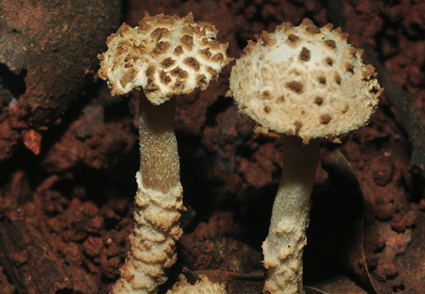Abstract
We present Cystolepiota flavolamellata a new species discovered in the tropical regions of Thailand and Laos. Morphological characters and multigene phylogenetic analyses, which encompass ITS, LSU, rpb2, and tef1 sequences, distinguish this species. Cystolepiota flavolamellata exhibits the following unique set of characteristics: basidiomata covered with light brown to brown granules or large pyramidal squamules; free yellowish white to light yellow lamellae; broadly ellipsoid to oblong-amygdaliform to ovoid basidiospores; absence of pleurocystidia; variably shaped cheilocystidia, i.e., oblong, clavate with or without appendicular apex, conical to utriform, fusiform; an epithelium for the pileus and stipe covering; and presence of clamp connections. Molecular analyses based on multiple genes confirm its separation from other known and sequenced Cystolepiota species.
References
- Alanbagi, R.A., Alshuwaili, F.E. & Stephenson, S.L. (2019) Fungi associated with forest floor litter in northwest Arkansas. Current Research in Environmental & Applied Mycology (Journal of Fungal Biology) 9 (1): 25–35. https://doi.org/10.5943/cream/9/1/3
- Albuquerque, M.P., de Carvalho Victoria, F., Egres, C.C., Putzke, J. & Pereira, A.B. (2017) Cystolepiota Singer (Agaricales) in Amazonia, Rio de Janeiro, Rio Grande do Sul (Brazil) and Tucumán (Argentina). Neotropical Biology and Conservation 12 (1): 48–58. https://doi.org/10.4013/nbc.2017.121.06
- Bon, M. (1976) Novitates. Documents Mycologiques 6 (24): 41–46. https://doi.org/10.1177/216507997602400612
- Bon, M. (1985) Novitates-Validations de taxons (ouvrage général en préparation). Documents mycologiques 15 (59): 51–52.
- Capella-Gutiérrez, S., Silla-Martínez, J.M. & Gabaldón, T. (2009) TrimAl: a tool for automated alignment trimming in large-scale phylogenetic analyses. Bioinformatics 25 (15): 1972–1973. https://doi.org/10.1093/bioinformatics/btp348
- Chandrasrikul, A., Suwanarit, P., Sangwanit, U., Lumyong, S., Payapanon, A., Sanoamuang, N., Pukahuta, C., Petcharat, V., Sardsud, U., Duengkae, K. & Klinhom, U. (2011) Checklist of mushrooms (Basidiomycetes) in Thailand. Office of Natural Resources and Environmental Policy and Planning, Bangkok, Thailand, 432 pp.
- Cubeta, M.A., Echandi, E., Abernethy, T. & Vilgalys, R. (1991) Characterization of anastomosis groups of binucleate Rhizoctonia species using restriction analysis of an amplified ribosomal RNA gene. Phytopathology 81 (11): 1395–1400. https://doi.org/10.1094/Phyto-81-1395
- Gardes, M. & Bruns, T.D. (1993) ITS primers with enhanced specificity for basidiomycetes—Application to the identification of mycorrhizae and rusts. Molecular Ecology 2: 113–118. https://doi.org/10.1111/j.1365-294X.1993.tb00005.x
- Hall, T. (1999) BioEdit: a user-friendly biological sequence alignment editor and analysis program for Windows 95/98/NT. Nucleic Acids Symposium Series 41: 95–98.
- Hou, Y.J. & Ge, Z.W. (2020) New species of Echinoderma and Lepiota (Agaricaceae) from China. Phytotaxa 447 (4): 221–236. https://doi.org/10.11646/phytotaxa.447.4.1
- Johnson, J. & Vilgalys, R. (1999) Phylogenetic relationships within Lepiota sensu lato inferred from nuclear and mitochondrial rDNA sequences. Mycologia 91: 443–458. https://doi.org/10.1080/00275514.1999.12061038
- Kalichman, J., Kirk, P.M. & Matheny, P.B. (2020) A compendium of generic names of agarics and Agaricales. Taxon 69 (3): 425–447. https://doi.org/10.1002/tax.12240
- Katoh, K. & Toh, H. (2008) Recent developments in the MAFFT multiple sequence alignment program. Briefings in Bioinformatics 9: 286–298. https://doi.org/10.1093/bib/bbn013
- Kornerup, A. & Wanscher, J.H. (1978) Methuen handbook of colour. 3rd ed.. Methuen Ltd, London, UK, 252 pp.
- Liu, Y.J., Whelen, S. & Hall, B.D. (1999) Phylogenetic relationships among ascomycetes: evidence from an RNA polymerse II subunit. Molecular Biology and Evolution 16 (12): 1799–1808. https://doi.org/10.1093/oxfordjournals.molbev.a026092
- Nylander, J.A., Ronquist, F., Huelsenbeck, J.P. & Nieves-Aldrey, J. (2004) Bayesian phylogenetic analysis of combined data. Systematic Biology 53 (1): 47–67. https://doi.org/10.1080/10635150490264699
- Osmundson, T.W., Robert, V.A., Schoch, C.L., Baker, L.J., Smith, A., Robich, G., Mizzan, L. & Garbelotto, M.M. (2013) Filling gaps in biodiversity knowledge for macrofungi: contributions and assessment of an herbarium collection DNA barcode sequencing project. PloS ONE 8 (4): 62419. https://doi.org/10.1371/journal.pone.0062419
- Qu, H., Damm, U., Hou, Y.J. & Ge, Z.W. (2023) Taxonomy and phylogeny of Cystolepiota (Agaricaceae, Agaricales): New species, new combinations and notes on the C. seminuda complex. Journal of Fungi 9 (5): 537. https://doi.org/10.3390/jof9050537
- Rehner, S.A. & Buckley, E. (2005) A Beauveria phylogeny inferred from nuclear ITS and EF1-α sequences: evidence for cryptic diversification and links to Cordyceps teleomorphs. Mycologia 97 (1): 84–98. https://doi.org/10.3852/mycologia.97.1.84
- Ronquist, F. & Huelsenbeck, J.P. (2003) MrBayes 3: Bayesian phylogenetic inference under mixed models. Bioinformatics 19 (12): 1572–1574. https://doi.org/10.1093/bioinformatics/btg180
- Saar, I. & Laessoe, T. (2008) A re-evaluation of Cystoderma luteojemisphaericum. Mycotaxon 104: 313–320.
- Sarawi, S., Shi, Y.N., Lotz-Winter, H., Reschke, K., Bode, H.B. & Piepenbring, M. (2022) Occurrence and chemotaxonomical analysis of amatoxins in Lepiota spp. (Agaricales). Phytochemistry 195: 113069. https://doi.org/10.1016/j.phytochem.2021.113069
- Singer, R. & Clémençon, H. (1972) Notes on some Leucosporous and Rhodosporous European agarics. Nova Hedwigia 23: 305–351.
- Singer, R. & Digilio, A.P. (1952) Pródromo de la flora agaricina Argentina. Lilloa 25: 5–461.
- Stamatakis, A., Hoover, P. & Rougemont, J. (2008) A rapid bootstrap algorithm for the RAxML web servers. Systematic Biology 57 (5): 758–771. https://doi.org/10.1080/10635150802429642
- Sysouphanthong, P., Thongklang, N., Liu, Y.S. & Vellinga, E.C. (2022) Three new species of Cystolepiota from Laos and Thailand. Diversity 14 (6): 449. https://doi.org/10.1080/10635150802429642
- Vellinga, E.C. (1987) Notes on Cystolepiota seminuda. Persoonia 13: 321–325.
- Vellinga, E.C. (2003) Phylogeny of Lepiota (Agaricaceae): evidence from nrITS and nrLSU sequences. Mycological Progress 2 (4): 305–322. https://doi.org/10.1007/s11557-006-0068-x
- Vellinga, E.C. (2004) Genera in the family Agaricaceae: evidence from nrITS and nrLSU sequences. Mycological Research 108 (4): 354–377. https://doi.org/10.1017/S0953756204009700
- Vellinga, E.C. (2006) Lepiotaceous fungi California, USA 4. Type studies of Lepiota fumosifolia and L. petasiformis. Mycotaxon 98: 205–212.
- Vellinga, E.C. & Huijser, H.A. (1998) Notes on Cystolepiota: sections Cystolepiota and Pulverolepiota. Persoonia 16: 513–526. Vellinga, E.C. (2001) Studies in Lepiota III. Some species from California, U.S.A. Mycotaxon 80: 285–296.
- Vellinga, E.C. & Noordeloos, M.E. (2001) Glossary. Flora Agaricina Neerlandica 5: 6–11.
- Vilgalys, R. & Hester, M. (1990) Rapid genetic identification and mapping of enzymatically amplified ribosomal DNA from several Cryptococcus species. Journal of Bacteriology 172 (8): 4238–4246. https://doi.org/10.1128/jb.172.8.4238-4246.1990
- White, T., Bruns, T., Lee, S. & Taylor, J. (1990) Amplification and direct sequencing of fungal ribosomal RNA genes for phylogenetics. In: Innis, M., Gelfand, D., Sninsky, J. & White, T. (Eds.) PCR Protocols: A guide to methods and applications. Academic Press, New York, NY, USA, pp. 315–322. https://doi.org/10.1016/B978-0-12-372180-8.50042-1


